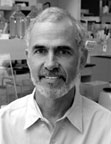 |
 |
|
 |
 |
 |
 |
 |
|
 |
 |
 |
 |

 |
 |
 |
 |

|
 |
Return to Table of Contents
 |
|
Matt Winkler
|
|
Meet MBL Alumnus Matthew Winkler
“Basically, I think every biologist hopes that when they die they’ll go to Woods Hole,” says Matt Winkler, founder and president of Ambion, a company that sells reagents to biomedical researchers. “That would be much better than going to heaven.”
If this is true, Winkler, an Embryology course alumnus and former instructor, has previewed heaven five times. Between 1979 and 1985 he spent four “idyllic Woods Hole summers” studying, conducting protein synthesis research, and instructing at the MBL. He returned a fifth time in 1988 to attend a sea urchin meeting and change the course of his life work.
Like many scientists, Winkler speaks fondly of his MBL days. He recalls synthesizing proteins alongside Tim Hunt before Hunt won the Nobel, driving a trailer of lab equipment to Woods Hole, and eating gourmet meals in a house he and Microscopy course instructor Kip Sluder once rented near Quissett. “Those summers included lots of research, lots of parties, interesting people to interact with, and getting a lot of work done,” says Winkler.
He first experienced the MBL as a student in the Embryology course the year Tom Humphreys and Joan Ruderman directed it. That’s when Winkler met Hunt, a fellow protein synthesis researcher, who would eventually make a breakthrough discovery of cyclin. Hunt was an Embryology course instructor and Winkler worked in his lab.
“It was a great convergence of interests,” says Winkler. “He was a protein synthesis person and I had developed a cell-free protein synthesis system from sea urchins as a graduate student.” The duo collaborated to try to understand the longstanding problem of how protein synthesis is regulated to fertilization. They worked so well together that Hunt invited Winkler back to the MBL two years later.
That was the summer Winkler almost thwarted Hunt’s future Nobel. Hunt was interested in the proteins that were synthesized in early development and was labeling sea urchin eggs and embryos with the radioactive isotope S35-methionine, fertilizing the eggs, then running tests at different time intervals to see what proteins were being made.
“Tim would add the methionine, fertilize the eggs, then every few minutes remove a little sample that he would fix to run on a gel,” says Winkler. “I, being an old sea-urchin hand, knew that wasn’t the ‘right’ way of doing the experiment.” So Winkler suggested Hunt fertilize the eggs, remove a small sample of eggs, then add the isotope, and repeat the process every 10 to 15 minutes. “But my ‘correct’ way was a lot more work,” says Winkler. “Luckily, Tim ignored me and did it the way he wanted, which happens to be the best way to see the cyclin protein. It showed up blatantly the way he did it, which led him to a whole new area of research and, eventually, the [2001] Nobel Prize.”
After that, Winkler would enjoy two more MBL summers. He returned in 1983 and 1985 as an Embryology course instructor with Bill Jeffery as head instructor. By then, Winkler was a professor and successful academic scientist in the zoology department at the University of Texas at Austin. His research there required the use of numerous reagents that were more expensive than his NIH grant could afford. So, to the delight of his scientific colleagues, he began to make (and share) his own.
Soon Winkler achieved tenure, but wearied of academic life. “I sensed people were having more fun doing science in industry than they were in academia,” he says. He considered leaving to start a company dedicated to creating high-quality reagents.
It was during a sea urchin meeting at the MBL in 1988 that Winkler’s idea began to differentiate. “I sat outside of Swope with a couple of friends I’d gone to graduate school with, went over a business plan, and made a decision to start the company,” he says.
He returned to Austin and started Ambion later that year. “My colleagues thought I was crazy when I left the university after I’d gotten tenure,” he says. One even described the new venture this way: “He left his tenured position at the university to put colored liquids into little tubes for his former colleagues.”
But Ambion’s earnings show these colored liquids are hot commodities. The company grew from $1,288 in sales in 1989 to $38.6 million in 2003. “Our customers buy products that help them isolate RNA, label RNA, copy RNA into DNA, and perform all kinds of molecular biology processes,” says Winkler. “Most segments of biomedical research use Ambion products.”
Matt Winkler’s company is a great success story. It’s profitable. It runs on the “strong senior scientist” model, which gives scientists substantial responsibilities for business as well as scientific issues. It has a steadfast environmental ethic. And it donates reagents to science courses at the MBL and Cold Spring Harbor Laboratory.
So does this successful scientist-turned-entrepreneur have any regrets? “By the time I got tenure, I knew I was comfortable leaving academia,” he says. “But I knew I would definitely miss the opportunity to spend summers in Woods Hole.”
|
|
| |
 |
|
 |
 |
|